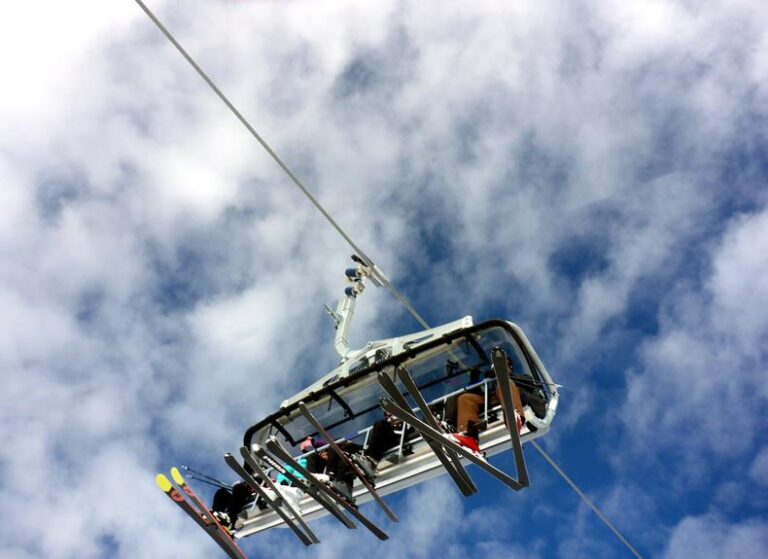Ski Lift Weight Limit – A Comprehensive Review
As you step onto the ski lift and feel the weightlessness of being suspended in the air, you can't help but wonder about the limits of this seemingly magical contraption. Ski lift weight limit, a topic shrouded in mystery and speculation, is something that every skier should consider.
How much weight can a ski lift handle? What happens if you exceed the weight limit? These questions linger in the back of your mind, urging you to unravel the secrets of ski lift safety.
So, let's dive into the world of ski lifts and explore the truth behind their weight limitations.
Types of Ski Lifts
There are various types of ski lifts, each serving a specific purpose and accommodating different numbers of passengers. When it comes to ski lifts, you need to be aware of their weight limits to ensure a safe and enjoyable experience on the slopes. The weight limits vary depending on the type of lift you're using.
The first type of ski lift is the drag lift. These lifts are designed for one or two skiers and are commonly used on beginner runs. They've a low weight capacity to minimize the risk of injury. So, if you're a beginner skier or if you're skiing with someone who's just starting out, the drag lift is a good option for you.
Next, we've chairlifts. These lifts can be found in almost every ski resort and come in various configurations and capacities. They can accommodate different numbers of passengers, ranging from smaller chairlifts for everyday use to larger ones in higher-end and busier resorts. Just make sure you don't exceed the weight limit indicated by the lift operator.
For those looking for a more comfortable ride, gondolas and cable cars are the way to go. Gondolas can accommodate up to 30 people comfortably, offering one of the safest ways to ascend the slopes. Cable cars, on the other hand, can carry a large number of skiers, with some able to carry up to 200 people at a time. These types of lifts have larger weight capacities ranging from six to 200 passengers.
Weight Limits for Different Lifts
If you're planning to hit the slopes, it's important to be aware of the weight limits for different ski lifts. Ski lifts have different weight limits and carrying capacities depending on their type and design. Engineers prioritize safety and account for various factors when determining how much weight a ski lift can hold. To give you a better understanding, here's a table outlining the weight limits for different types of ski lifts:
| Type of Ski Lift | Weight Capacity |
|---|---|
| Drag Lift | 1-2 skiers |
| Chairlift | Up to 3,000 kg |
| Gondola | Up to 15,000 kg |
Drag lifts are typically meant for one or two skiers and have a lower weight capacity. They are often used for beginner runs. Chairlifts come in various configurations and can safely carry up to 3,000 kg, accommodating different numbers of passengers. Gondolas, on the other hand, can comfortably accommodate up to 30 people and have a maximum weight capacity of about 15,000 kg. It's crucial to note that ski lifts are designed with a safety factor, ensuring that the weight capacity is never exceeded and prioritizing the safety of individuals. So, even if you're on the heavier side, you can still enjoy skiing without worrying about exceeding the prescribed carrying capacity. Larger chairlifts are specifically designed to accommodate heavier individuals, so everyone can have a safe and enjoyable skiing experience.
Do Ski Lifts Have a Weight Limit?
Ski lifts have specific weight limits to ensure the safety of passengers and prevent exceeding the carrying capacity. It's important to know the weight limits of ski lifts before getting on them, as exceeding these limits can pose a risk to both the riders and the lift itself. Here are three key points to consider about ski lift weight limits:
- Different types of lifts have different weight limits: Drag lifts, which are commonly used for beginner runs, have low weight capacities and are usually meant for one or two skiers. Chairlifts come in various configurations and capacities, with six-person chairlifts safely carrying up to 3,000 kg. Gondolas, the largest and most comfortable ski lifts, can accommodate up to 30 people and have a maximum weight capacity of about 15,000 kg.
- Weight limits prioritize safety: Ski lifts are engineered with safety factors in mind, taking into account various factors such as the lift's design, type, and intended use. These weight limits are in place to ensure that the lift can safely carry and accommodate the weight of passengers without compromising their well-being.
- Exceeding weight limits can lead to accidents: If the weight limit of a ski lift is exceeded, it can put excessive strain on the lift's mechanical components, potentially leading to malfunctions or accidents. It's important for skiers and snowboarders to be aware of their weight and the weight limits of the lifts they're using to avoid any potential risks.
How Powerful Are Ski Lifts?
After understanding the weight limits of ski lifts, it's important to consider the power and capabilities of these lifts. Ski lifts aren't only designed to safely carry skiers and snowboarders up the slopes but also to withstand the weight and pressure exerted on them. The weight limit of a ski lift depends on its type, design, and capacity.
Gondolas, for example, can hold up to 30 people comfortably and have a maximum weight capacity of around 15,000 kg. These are some of the largest and most powerful ski lifts, offering a comfortable and spacious ride up the mountain.
Chairlifts, on the other hand, come in various configurations and have different weight capacities. Some larger chairlifts can safely carry up to 3,000 kg or six passengers. These lifts are designed to efficiently transport skiers and snowboarders to the top of the slopes.
Cable cars, similar to gondolas, have impressive capabilities. They can accommodate a large number of skiers, with some capable of carrying up to 200 people at a time. These cable cars are powerful enough to handle approximately 1,750,000 kg every hour.
It's important to note that ski lifts are designed with a safety factor, allowing them to carry more weight than their prescribed maximum capacity. This ensures the safety of skiers and lift users, as the lifts are built to handle unexpected loads and variations in weight distribution.
Understanding the power and capabilities of ski lifts is crucial for ensuring the safety and efficiency of mountain transportation. Ski lift operators carefully consider weight limits and capacities to provide a comfortable and secure experience for all riders.
Can You Fall off a Ski Lift?
Falling off a ski lift is a rare occurrence, with safety measures in place to prevent accidents. Ski lifts are designed with the utmost concern for rider safety. Here are a few reasons why falling off a ski lift is unlikely:
- Well-designed lifts: Ski lifts are constructed with safety bars and doors to prevent falls while getting on or off. These features provide stability and security for riders, especially beginners who may be more prone to accidents.
- Higher weight capacity: Ski lifts are engineered to accommodate multiple riders safely. Although there's no specified weight limit, some resorts may have weight restrictions for certain lifts to ensure the safety of all passengers. However, overweight skiers need not worry, as ski lifts are designed to handle a range of weights without compromising safety.
- Focus on safety: Engineers prioritize safety when designing ski lifts. They take into account various factors, such as weather conditions and the terrain, to ensure that the lifts can operate safely and securely.
Frequently Asked Questions
Can You Ski if You Are Overweight?
Yes, you can ski if you're overweight. While there are health risks, skiing can be enjoyable with proper preparation. Focus on weight management, choose accessible ski resorts, and use suitable equipment. Embrace your body and find inspiration from others who excel at skiing.
How Many Pounds Can a Chairlift Hold?
A chairlift can hold a maximum weight capacity determined by safety regulations. Ski lifts are designed to accommodate a certain number of passengers and distribute weight evenly. Exceeding weight limits can impact the safety measures in place.
How Many People Can Ride Ski Lift?
You can ride a ski lift with a certain number of people, depending on its capacity. The maximum occupancy and weight restrictions are determined for safety reasons. Ski resorts manage capacity during peak times to avoid long wait times. Ski lift attendants enforce weight limits.
How Much Do Ski Lift Chairs Weigh?
Ski lift chairs weigh between 300 to 500 pounds. They are designed to safely carry more weight than their capacity allows, ensuring ski lift safety and reliability. Ski lift maintenance and upgrades are essential for smooth ski lift operations.
Conclusion
So, in conclusion, while ski lifts may not have a specified weight limit, it's important to consider your weight for safety reasons when participating in skiing activities.
Although ski lifts are designed with a safety factor that allows them to carry more weight than their prescribed maximum capacity, it's still advised for individuals above 220 pounds to be cautious.
With the proper precautions and trust in the safety measures of ski lifts, skiers can enjoy their skiing experience.






